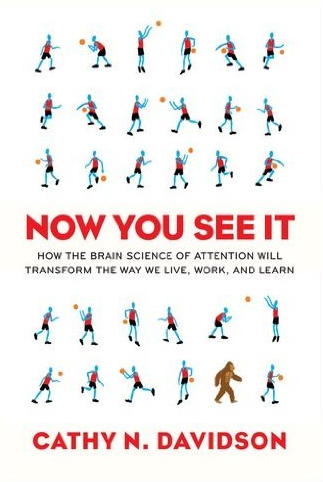How the Science of Attention is Changing Work and Education
by Maria Popova, brainpickings.orgAugust 19th 2012 8:11 PM
by
What a woman in a gorilla suit has to do with the future of work and education in the digital age.
 Much has been said about how the Internet is changing our brains and what this new culture of learning means for the future of education. While much of the dialogue has been doused in techno-dystopian alarmism, from Alvin Toffler’s Future Shock, narrated by Orson Welles in the 1970s, to Nicholas Carr’s reductionist claims about attention in today’ digital age. But the truth about attention, as it relates to the intersection of technology and education, seems to be a lot more layered and complex — and, if Cathy Davidson, founder of Duke University’s Center for Cognitive Neuroscience, is right, a lot less worrisome. That’s precisely what Davidson illustrates in her new book, Now You See It: How the Brain Science of Attention Will Transform the Way We Live, Work, and Learn — a fascinating meditation on how “attention blindness,” the peculiar phenomenon illustrated by Harvard’s famous invisible gorilla experiment, has produced one of our culture’s greatest disconnects, the inability to reconcile the remarkable changes induced by the digital age with the conventions of yesteryear’s schools and workplaces.
Much has been said about how the Internet is changing our brains and what this new culture of learning means for the future of education. While much of the dialogue has been doused in techno-dystopian alarmism, from Alvin Toffler’s Future Shock, narrated by Orson Welles in the 1970s, to Nicholas Carr’s reductionist claims about attention in today’ digital age. But the truth about attention, as it relates to the intersection of technology and education, seems to be a lot more layered and complex — and, if Cathy Davidson, founder of Duke University’s Center for Cognitive Neuroscience, is right, a lot less worrisome. That’s precisely what Davidson illustrates in her new book, Now You See It: How the Brain Science of Attention Will Transform the Way We Live, Work, and Learn — a fascinating meditation on how “attention blindness,” the peculiar phenomenon illustrated by Harvard’s famous invisible gorilla experiment, has produced one of our culture’s greatest disconnects, the inability to reconcile the remarkable changes induced by the digital age with the conventions of yesteryear’s schools and workplaces.
As long as we focus on the object we know, we will miss the new one we need to see. The process of unlearning in order to relearn demands a new concept of knowledge not as thing but as a process, not as a noun but as a verb.” ~ Cathy Davidson
In another famous experiment, Davidson, then provost at Duke, gave the entire 2003 freshman class iPods as part of their academic curriculum. Though the pilot project was at first widely derided, it quickly silenced the critics as students found intelligent and innovative ways to employ their iPods in the classroom and the lab in everything from collaborating on group project to podcasting a conference on Shakespeare around the world.

Davidson uses the insights from these experiments as a lens through which to examine the nature and evolution of attention, noting that the educational system is driven by very rigid expectations of what “attention” is and how it reflects “intelligence,” a system in which students who fail to meet these expectations and pay attention differently are pigeonholed somehow deficient of aberrant, square pegs in round holes. Yet neuroscience is increasingly indicating that our minds pay attention in a myriad different ways, often non-linear and simultaneous, which means that the academy and the workplace will have to evolve in parallel and transcend the 20th-century linear assembly-line model for eduction and work. (The assembly and the factory are in fact a familiar metaphor from Sir Ken Robinson’s insightful thoughts on changing educational paradigms.)
Refreshingly constructive and glimmering with much-needed optimism about the future of education in the digital age, Now You See It makes a fine new addition to these 7 essential books on education and offers a well-argued antidote to the media’s incessant clamor about the deadly erosion of our attention.
Thanks, Jake
Original Page: http://www.brainpickings.org/index.php/2011/08/19/now-you-see-it-cathy-davidson/
Shared from Read It Later
No comments:
Post a Comment